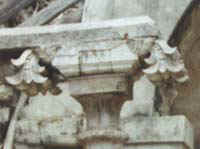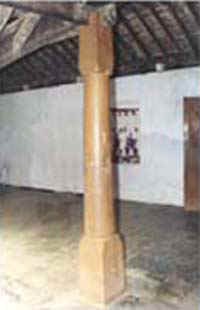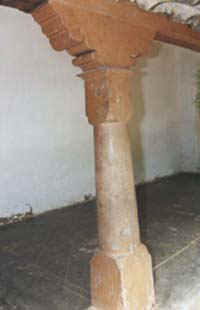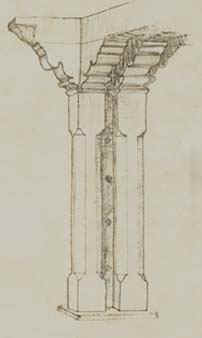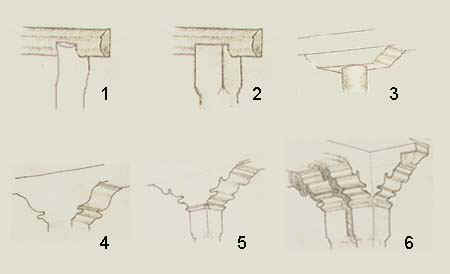 |
 |
||||||||||||||||||||||||||||||||||||||||||||||||||||
|
Columns as Decorative Elements - 1Columns are among the major elements which contribute to the aesthetics of any building. Columns give character to the architecture of various periods, regions and cultures. In the past the columns were elaborately decorated, irrespective of the materials used. Jaffna Houses are not exemptions. We do not have any examples of columns that can be clearly assigned to the pre-colonial architecture of Jaffna. Few column capitals which are found in "Manthirimani", that is considered as a Dutch building, might belong to pre-colonial period, possibly used here from the palace of the former minister of Jaffna kingdom which once stood in this site or from other nearby pre-colonial building. (Fig:1 and 2)
These column capitals clearly belongs to late Dravidian style. Proper study is required to determin their period of origin. Although the columns are of wood, it seems that they were made to match the other coral stone columns which are obviously Dutch in character. The basic Jaffna village houses of thatch, wood and mud are very simple in construction and the columns are just jungle wood posts with all their natural irregularities. The roof frame was supported directly on them without any bracket or capital (Fig:6.1). Columns of Traditional Houses and other buildingsThe traditional houses built out of permanent materials had columns decorated to give more aesthetic appeal. The columns belong to the earlier types of traditional houses were of wood. The oldest among them had thicker columns. Most of the examples which are discussed here were built during 19th century and after. However the available stock of buildings cover concepts, planning, techniques, materials and styles bolong to much longer time back in the history.
The wooden columns found in the traditional houses can be divided into two groups for convenience. One group consists of columns which support the roof along the periphery, specificaly supporting the end of the roof along the outer edge of the "thinnai"s, or around the court yards (Fig:3 and 4). These columns are very short and genarally have bulky proportions. The other group consists of columns located at inner areas and support roof directly or support short walls which support the roof above. (Fig:5)
The columns of this group are taller and more slender in proportion as they have to reach high to support the roof above at these locations. Some times twin columns were provided at these locations, as this arrangement was necessary in case a thick wall was to be supported on them. Generally the columns in this group, if single, have four faced capitals. Twin columns were generally provided with a six faced capital. Both these types of columns mostly consists of Three parts, which will be referred here as top, middle and bottom. Top and bottom always have a square section, the middle part, in majority of cases are circular and in few cases they are polygonal in section (Fig:5). One can see a variety of column capitals in traditional houses, in terms of sophistication. It should be understood that these differences in sophistication do not indicate any chronological order of construction of these respective buildings, but they simply suggest that the house holders chose a particular type based on various criterion including their affordability, from a stock that represent styles since a point of time further back in history.
|
||||||||||||||||||||||||||||||||||||||||||||||||||||
| Last updated on 30 January 2005 | |||||||||||||||||||||||||||||||||||||||||||||||||||||
YOUR VISITOR NO. TO THIS SITE IS  THANK YOU. THANK YOU. |
|||||||||||||||||||||||||||||||||||||||||||||||||||||

